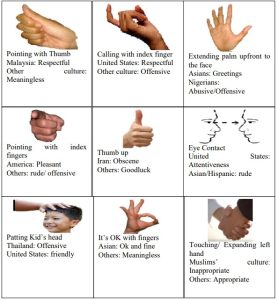Culture
Non-verbal Communication and Symbols
Maggie Convey
Non-verbal communication differs across culture, and simple gestures that you may know to be normal in your culture, may have very different meanings for individuals of other cultural groups. Consider the following:
- Eye contact: Different cultures have different views on eye contact and its meeting and its meaning generally, maintaining eye contact suggests self-confidence and honesty, but there are some cultures that perceive prolonged eye contact as being impolite. Further, failing to look into somebody’s eyes may give an individual a sense that you are being shy or lack self-confidence, and also may trigger negative emotions that convey disrespect, dishonesty, or inattentiveness. Avoiding eye contact may also point to a condescending attitude. Some cultures do not value eye contact as much as westerners do. In some Asian countries, direct eye contact is uncomfortable and is considered impolite. Also, In some cultures eye contact is connected to status and can be a reflection of power relationships. Generally, the person holding the superior position will engage in prolonged eye contact, while subordinates are more likely to look away. It is important to pay attention to the cues you are receiving from the individuals with whom you are speaking.
- Greetings too vary by culture. While westerners may greet with a firm handshake, that same gesture may be inappropriate–especially if this occurs between members of different genders. Individuals may prefer to greet others without the use of touch, or even with a hug.
- Hand gestures may also confer different connotations. Some gestures that are common in Canada, like using a ‘thumbs up’, has a rude connotation in Australia and West Africa. Even nodding of the head may indicate different meanings.

Media Attributions
- Screenshot 2021-11-19 104329
